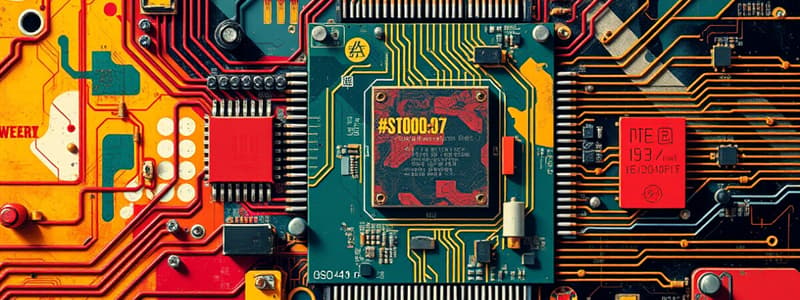Podcast
Questions and Answers
What are the key considerations to ensure correctness in embedded systems software?
What are the key considerations to ensure correctness in embedded systems software?
The program must be logically and temporally correct, addressing delays and timeouts.
What aspect of embedded systems design deals with managing the physical concurrency inherent in them?
What aspect of embedded systems design deals with managing the physical concurrency inherent in them?
Reactive systems address the challenges of physical concurrency in embedded system design.
Explain why reliability and fault-tolerance are critical in the context of embedded systems.
Explain why reliability and fault-tolerance are critical in the context of embedded systems.
Reliability and fault-tolerance are critical because embedded systems often operate in safety-critical applications where failures can lead to severe consequences.
In embedded system design, how can one meet crucial deadlines?
In embedded system design, how can one meet crucial deadlines?
Identify two major considerations when designing for power consumption in embedded systems.
Identify two major considerations when designing for power consumption in embedded systems.
What are the multi-objective goals in embedded system design?
What are the multi-objective goals in embedded system design?
How does the size of the CPU and memory impact an embedded system's design?
How does the size of the CPU and memory impact an embedded system's design?
List three design goals for embedded systems aside from performance.
List three design goals for embedded systems aside from performance.
What are the key phases involved in the design and development process of embedded systems?
What are the key phases involved in the design and development process of embedded systems?
How do functional and non-functional requirements differ in embedded systems?
How do functional and non-functional requirements differ in embedded systems?
Explain the difference between top-down and bottom-up design approaches in embedded systems.
Explain the difference between top-down and bottom-up design approaches in embedded systems.
What are some design challenges posed by embedded systems?
What are some design challenges posed by embedded systems?
What is the significance of reliability in embedded systems?
What is the significance of reliability in embedded systems?
In the context of embedded systems, what is meant by 'architecture'?
In the context of embedded systems, what is meant by 'architecture'?
Why are real-time operating systems (RTOS) important for embedded systems?
Why are real-time operating systems (RTOS) important for embedded systems?
Name a common example of an embedded system and its application.
Name a common example of an embedded system and its application.
What are the three main components of an embedded system?
What are the three main components of an embedded system?
Differentiate between hard real-time and soft real-time systems in embedded systems.
Differentiate between hard real-time and soft real-time systems in embedded systems.
What is a key characteristic that defines an embedded system's functionality?
What is a key characteristic that defines an embedded system's functionality?
How does an embedded system differ from a general-purpose computer?
How does an embedded system differ from a general-purpose computer?
What role does the real-time operating system (RTOS) play in embedded systems?
What role does the real-time operating system (RTOS) play in embedded systems?
Give an example of an application of embedded systems in everyday devices.
Give an example of an application of embedded systems in everyday devices.
What is the significance of software in an embedded system?
What is the significance of software in an embedded system?
What defines the reliability of an embedded system?
What defines the reliability of an embedded system?
Flashcards are hidden until you start studying
Study Notes
Introduction to Embedded Systems
- Programs must be logically and temporally correct, incorporating elements such as delays and timeouts.
- Systems should handle physical concurrency and function as reactive systems.
- Reliability and fault tolerance are crucial in embedded systems.
- These systems are typically application-specific and serve a single purpose.
Challenges in Embedded System Design
- Determining necessary hardware specifications including CPU word size and memory size is essential.
- Meeting deadlines requires balancing faster hardware with clever software solutions.
- Minimizing power consumption is critical; strategies include disabling unnecessary logic and reducing memory accesses.
Embedded System Design Overview
- Involves multiple objectives and disciplines throughout its life-cycle.
- Key considerations include dependability, affordability, safety, security, scalability, and timeliness.
- Interdisciplinary fields involved are electronic hardware, software, mechanical hardware, control algorithms, and human factors.
Design Goals
- Performance is gauged by overall speed and ability to meet deadlines.
- User interface functionality is an important focus.
- Manufacturing costs and power consumption must be optimized.
- Additional requirements include physical size and other specific design constraints.
Design and Development Process
- The process includes defining requirements, creating specifications, establishing architecture, designing components, and integrating the system.
Functional vs. Non-Functional Requirements
- Functional requirements specify outputs based on inputs.
- Non-functional requirements encompass various aspects such as computation time, physical dimensions, weight, power consumption, and reliability.
Design Approaches
- Top-down Design: Begins with an abstract description and gradually moves to detailed designs.
- Bottom-up Design: Starts with small components and builds towards a full system.
- Actual design processes often utilize both approaches.
Conclusion on Embedded Systems
- Embedded systems are prevalent in everyday life and introduce numerous design challenges including time constraints, power consumption, and overall design duration.
Definitions and Components
- An embedded system integrates a microprocessor or microcontroller with software to perform specific tasks, distinguishing it from general-purpose computers.
- Consists of three main components: hardware, application software, and a real-time operating system (RTOS).
RTOS Types
- Hard Real-Time: Failure to meet deadlines results in system failure.
- Soft Real-Time: Missing deadlines leads to degraded performance instead of complete failure.
Characteristics of Embedded Systems
- Typically single-function devices that perform designated operations repetitively.
Studying That Suits You
Use AI to generate personalized quizzes and flashcards to suit your learning preferences.




